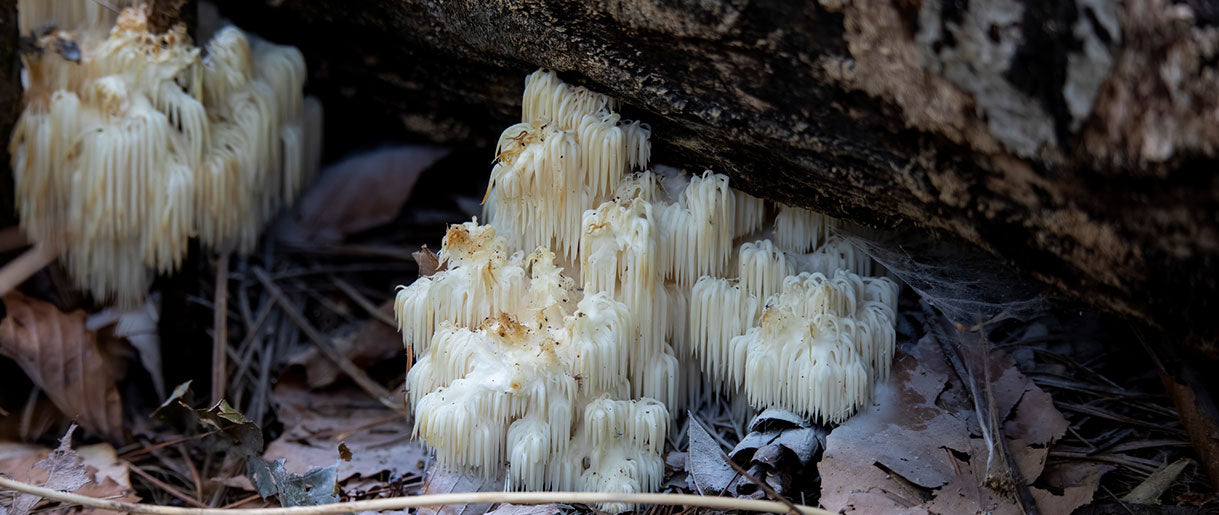Lion's Mane mushroom (Hericium erinaceus) is a distinctive, edible fungus known for its unique appearance and potential medicinal properties. Common look-alikes include Bear's Head Tooth (Hericium americanum), Comb Tooth (Hericium coralloides), and White Coral Fungus (Clavulina cristata). Each of these mushrooms has similarities to Lion's Mane but can be differentiated by observing key differences in shape, size, color, texture, and growth patterns.
Proper identification is crucial for safe foraging as it can help avoid unsafe look-alikes. If you are new to foraging Lion's Mane, consider engaging with the mycological community, participating in workshops, or joining guided walks to ensure accurate identification and ethical harvesting practices.
In this detailed article, you will learn how to identify Lion's Mane mushrooms in the wild and separate them from the Lion's Mane look-alikes. We will also answer the most frequently asked questions about edible mushrooms like Lion's Mane.
Characteristics of Lion's Mane Mushroom

The Lion's Mane is a highly sought-after medicinal and delicious edible mushroom. In addition to the health benefits of Lion's Mane, it's common for people to eat Lion's Mane as a replacement for meat in vegan diets because of its meat-like texture and seafood-like taste. However, to safely identify Lion's mane mushrooms, it's essential to understand their physical features and habitats.
Physical Features
Description Of Fruiting Body
Lion's Mane, also known as monkey head mushrooms or bearded tooth fungus, have a distinctive appearance. The fruiting body features a white, spherical structure covered in long, cascading, icicle-like spines that resemble a shaggy mane.
As the mature Lion's mane mushroom ages, its color changes from pure white to a more yellowish hue. The Lion's mane mushroom smell is mild and pleasant, often compared to seafood.
Interesting Read: Understand the difference between Lion's Mane fruiting body and mycelium.
Spore Print Color
Regarding Lion's mane mushroom identification, spore print color is a helpful tool. The spore print of Lion's Mane is white, which can aid in distinguishing it from its look-alikes.
Growth Habits
Lion's mane mushrooms grow on hardwood trees, primarily on wounds or areas where branches have broken off. They can appear as a single fruiting body or in clusters.
Habitat And Distribution
Preferred Growing Conditions
These wild mushrooms thrive on decaying or dead hardwood trees, such as oak or beech, in moist, temperate forests. Lion's mane mushrooms favor cooler temperatures and are typically found in the fall, although they can sometimes appear in late summer or early winter.
Geographical Range
Lion's Mane is widely distributed across North America, Europe, and Asia. In addition, wild Lion's Mane can be found in various forests throughout these regions, making them a popular target for mushroom foraging enthusiasts.
However, it is crucial to be aware of Lion's mane mushroom look-alikes and practice proper identification techniques to ensure a safe and enjoyable foraging experience.
Common Lion's Mane Mushroom Look-Alikes
Lion's Mane, known scientifically as Hericium erinaceus, is a nutritious and curiously unique mushroom variety. However, several Lion's mane mushroom look-alikes are often confused with the real deal. Here, we discuss three common Lion's mane look-alikes and how to distinguish them from the genuine Lion's mane Hericium erinaceus.
1. Bear's Head Tooth (Hericium americanum)

Similarities to Lion's Mane
The Bear's Head Tooth is another member of the Hericium genus and is closely related to Lion's mane mushroom. Both mushrooms have icicle-like teeth and grow on living trees or dead logs in deciduous hardwood habitats. They are both edible fungi and are considered medicinal mushrooms.
Key Differences
While similar in appearance, the Bear's Head Tooth has some notable differences. Its teeth are longer and more clustered than the Lion's mane mushroom. Additionally, the Bear's Head Tooth typically grows in a more branched structure than the more rounded form of the Lion's Mane.
Edibility and Uses
Like the Lion's mane mushroom, the Bear's Head Tooth is a delicious edible mushroom that can be cooked and added to your dinner plate. They can be eaten raw or cooked; their flavor and texture are similar to Lion's Mane. In addition, the medicinal benefits of Lion's Mane, such as supporting brain health and reducing inflammation, are also present in the Bear's Head Tooth.
2. Comb Tooth (Hericium coralloides)

Similarities to Lion's Mane
Also known as the Coral Tooth Fungus, the Comb Tooth is another Lion's mane look-alike within the Hericium genus. It shares a similar habitat, growing on dead logs or living trees, and has icicle-like teeth. Like the Lion's Mane, the Comb Tooth is an edible and medicinal mushroom.
Key Differences
The Comb Tooth has more coral-like branches and a less dense appearance than Lion's Mane. Its teeth are also shorter and more clustered, giving it a distinct appearance compared to the Lion's Mane.
Edibility and Uses
The Comb Tooth is a safe and tasty edible fungus, though it may not be as tender or flavorful as Lion's Mane. Nevertheless, it offers similar medicinal benefits to Lion's Mane, making it a valuable find for those seeking nutritious mushrooms.
Interesting Read: Learn about Lion's Mane's nutritional benefits.
3. White Coral Fungus (Clavulina cristata)

Similarities to Lion's Mane
At first glance, the White Coral Fungus may resemble Lion's mane mushroom due to its white color and branched structure. It grows on dead logs in the same deciduous hardwood habitat as Lion's Mane.
Key Differences
The White Coral Fungus has a more delicate, coral-like structure with thin, branching tendrils, distinguishing it from the more robust Lion's mane mushroom with its icicle-like teeth. Additionally, it belongs to a different fungal family and is not a member of the Hericium genus.
Edibility and Uses
While the White Coral Fungus is an edible mushroom, it is not considered medicinal, like Lion's Mane or other Hericium species. Its flavor and texture are also less desirable than Lion's Mane's, making it a less popular choice for the dinner table.
Tips for Differentiating Lion's Mane from Look-Alikes

Lion's Mane is a highly prized functional mushroom known for its culinary and medicinal properties, especially in traditional Chinese medicine. However, several Lion's mane mushroom look-alikes can be easily confused with the real deal. Here are some tips to help you accurately differentiate Lion's mane mushrooms from their look-alikes.
Observe Physical Characteristics
Shape and Size
Lion's mane mushrooms have a distinct globe-shaped fungus with icicle-like teeth hanging from the fruiting body. The shape and size of Lion's Mane are often more rounded than many mushrooms, including their look-alikes like the Bear's Head Tooth, which has a more branched structure.
Color and Texture
A fresh Lion's mane mushroom is typically white with a soft and delicate texture. As it ages, it may turn a faded orange color. Look-alikes such as the Hedgehog mushroom or Mountain Priest mushroom have different colors and textures, making distinguishing them from Lion's Mane easier.
Spore Print Comparison
Comparing spore prints can also help differentiate Lion's mane mushrooms from their look-alikes. For example, Lion's mane mushrooms produce a white spore print, while other Hericium species and look-alikes may have different spore print colors.
Analyze Habitat and Growth Patterns
Host Tree Species
The Lion's mane mushroom primarily grows on hardwood species, such as oak or beech trees, and is often found on dead trees or fallen logs. Therefore, observing the host tree species can help differentiate Lion's Mane from other wild mushrooms that grow on different tree types.
Seasonal Timing
As a cool weather mushroom, Lions mane mushrooms are most commonly found in the fall, although they can also appear in late summer or early winter. Monitoring the seasonal timing of your foraging excursions can help ensure you're finding true Lion's mane mushrooms.
Elevation and Geographical Range
The Lion's mane mushroom has a wide geographical range, including North America, Europe, and Asia. However, they typically grow at specific elevations within these regions. Therefore, researching the typical elevations and habitats for Lion's mane mushrooms in your area can help avoid confusing them with other Hericium mushrooms or look-alikes.
Safe and Responsible Foraging Practices

Foraging for Lion's mane mushroom can be a rewarding and enjoyable experience, but it's essential to practice safe and responsible foraging to protect both yourself and the environment. Here are some guidelines to follow when foraging for Lion's mane mushrooms and other medicinal mushrooms.
Ensure Proper Identification
Proper mushroom identification is crucial to avoid toxic mushrooms, which can have severe health consequences. For example, Lion's Mane has a seafood-like flavor, but it's essential to be confident in distinguishing it from look-alikes before consuming it.
Practice Ethical Harvesting Techniques
Preserve the Mushroom's Environment
When foraging for Lions mane mushrooms, it's essential to be mindful of their habitat, including the oak trees and other hardwoods they grow on. Be careful not to cause any damage to the trees or surrounding environment, as this can negatively impact the ecosystem and the mushrooms' ability to grow in the future.
Ensure Future Growth
To ensure that Lion's mane mushroom and other fungi continue to thrive, harvest only a portion of the mushrooms you find, leaving some behind for spore dispersal and future growth. This practice helps maintain a healthy population of mushrooms and allows others to enjoy foraging.
Engage with the Mycological Community
Join Local Clubs Or Online Groups
Connecting with other mushroom enthusiasts can help improve your foraging skills and knowledge of mushroom identification. Join local mycological clubs or online groups to share your experiences, ask questions, and learn from others who share your passion for mushrooms.
Participate In Foraging Workshops And Guided Walks
Participating in foraging workshops and guided walks led by experienced foragers or mycologists can significantly enhance your understanding of mushrooms and their habitats. In addition, these events often provide hands-on learning opportunities to help you become more proficient in identifying Lions mane mushrooms and other species safely and accurately.
FAQs About Lion's Mane Look-Alikes
Does Lion's Mane Have Toxic Look-Alikes?
Lion's mane mushroom does not have toxic look-alikes. The most common look-alikes, such as Bear's Head Tooth (Hericium americanum) and Comb Tooth (Hericium coralloides), are also edible and considered medicinal mushrooms.
However, practicing proper identification techniques when foraging mushrooms is essential to ensure you consume a safe and edible species.
Can I Grow Lion's Mane Mushrooms At Home?
Yes, you can grow Lion's mane mushrooms at home. Growing Lion's mane mushrooms is a relatively straightforward process that can be done using a mushroom grow kit or by creating your substrate and inoculating it with Lion's mane mushroom spawn.
Mushroom grow kits are the easiest way to get started, as they come with pre-inoculated substrate and instructions on how to grow Lion's mane mushrooms. Follow the instructions provided with the kit, and you should see your Lion's mane mushrooms begin to grow in a few weeks.
Is Lion's Mane Addictive?
No scientific evidence suggests that Lion's mane mushrooms are addictive. Lion's Mane is a medicinal mushroom used for centuries in traditional Chinese medicine and is known for its potential cognitive and neurological health benefits.
Lion's Mane has no addictive substances, and no studies have reported addictive properties related to the consumption of Lion's mane mushrooms. However, as with any supplement or food, consuming Lion's mane mushrooms in moderation is essential. Please consult a healthcare professional on how much Lion's Mane should be incorporated into your diet.
Key Takeaways
In this article, we have explored the fascinating world of Lion's mane mushrooms and their look-alikes, delving into their unique characteristics, similarities, and differences. By understanding Lion's mane mushrooms' critical features and common look-alikes, such as Bear's Head Tooth, Comb Tooth, and White Coral Fungus, you can confidently and accurately identify Lion's Mane in the wild and appreciate its culinary and medicinal properties.
As you embark on your foraging journey, we encourage you to practice safe and responsible foraging techniques. Proper identification is essential to consume safe and edible mushrooms, while ethical harvesting helps preserve the natural environment and ensure the continued growth of these valuable resources. In addition, by engaging with the mycological community and participating in workshops and guided walks, you can continue to learn and expand your knowledge of mushrooms and their habitats.
We invite you to share your experiences, insights, and stories about foraging for and trying to find Lion's mane mushrooms and other wild fungi. You can inspire and educate others by sharing your knowledge and passion for the monkey head mushroom, fostering a greater appreciation for these fascinating organisms and the natural world.









Let Us Know Your Comments